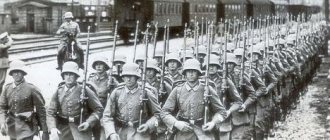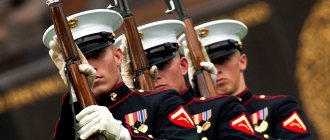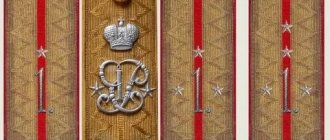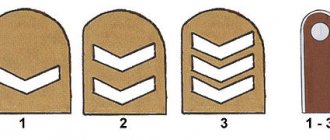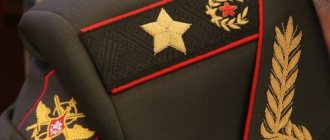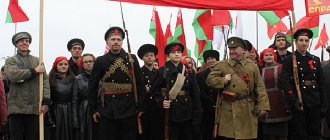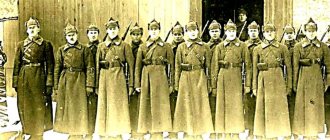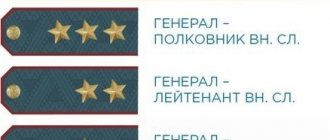In the Red Army (Red Army) two types of buttonholes were used: everyday (“colored”) and field (“khaki”). In turn, they were diamond-shaped and parallelogram-shaped.
Everyday buttonholes were introduced back in 1922. Since then they were constantly modernized until 1940. With the outbreak of the war, modernization was stopped because field single-color khaki buttonholes were introduced, which, along with everyday colored buttonholes, existed until the buttonholes were replaced with shoulder straps at the beginning of 1943.
The color scheme was very varied and quite complex. The color of the buttonhole field corresponded to the branch of the military (see table below), and the color and (or) shape of the edging indicated membership in the command or superior personnel.
For example, the everyday buttonholes of a captain, commander of a rifle company, had a crimson field color and a golden 5-mm braid along the edges (see diagram below). And the political instructor of this company wore buttonholes with a crimson field color, but with black edging.
Cadets of military schools, police and government agencies. Security had its own schemes for everyday buttonholes.
Field buttonholes were introduced by order of the USSR NKO No. 253 of August 1, 1941, which abolished the wearing of colored insignia for all categories of military personnel. It was ordered to switch to buttonholes, emblems and insignia of completely green khaki color (
). However, in conditions of war and the rapid increase in the size of the army, protective buttonholes and insignia were received mainly by military personnel mobilized from the reserves. In peacetime, a uniform with wartime insignia was prepared for them. The rest switched to new signs whenever possible. A number of military leaders opposed the transition to wartime insignia. For example, the commander of the 9th Mechanized Corps of the Kyiv Special Military District, Lieutenant General Rokossovsky K.K. By his order, he categorically forbade all commanders to change their insignia to field insignia, believing that the Red Army soldiers should see their commanders in battle.
Difficulties in supply led to the fact that the troops simultaneously encountered both those and other insignia in a variety of combinations (red cubes and sleepers on field buttonholes, field cubes and sleepers on colored buttonholes, etc.). This situation lasted until the army switched to shoulder straps in the winter-spring of 1943, and in the rear districts until mid-summer of 1943.
Since the field buttonholes were completely khaki for all categories of military personnel and differed only in the number of insignia, there is no point in examining them in detail.
Buttonhole sizes in the Red Army (Red Army):
- Buttonholes for tunics and jackets are in the form of a parallelogram, 32.5 mm wide including piping, about 10 cm long.
- Buttonholes for overcoats are diamond-shaped, 11 cm on the larger diagonal and 8.5-9 cm on the smaller one. One upper (edged) side had a length from corner to corner of 6.5 cm.
- General's buttonholes are diamond-shaped, length from corner to corner is 11 cm, width from corner to corner is 7.5 cm, length of the edged side is 6.1 cm, width of the edge of the buttonholes with gimp is 2.5 mm. The buttonholes on the general's overcoats were slightly larger - the length from corner to corner was 11.5 cm (13.5 cm for the Marshal of the Soviet Union), the width from corner to corner was 8.5 cm, the length of the edging side was 6.5 cm, the width of the edging buttonholes with 2.5 mm gimp.
Sewing buttonholes of the Red Army (RKKA):
- folding the unedged edge under the collar - (
) (
). - the unedged edge of the buttonhole was sewn into the collar - (
) (
). - exactly along the edge of the collar - (
) (
).
Colors of everyday buttonholes of the Red Army:
- open table (table under development...)
Military ranks of the USSR Armed Forces 1935-1945. (table of ranks):
- open table (table under development...)
Buttonholes for privates and junior command personnel of the Red Army (privates, sergeants and foremen)
Buttonholes for gymnasts and French jackets - in the form of a parallelogram. The color of the buttonhole field corresponded to the branch of the army. Colored edging on three sides.
Overcoat buttonholes are diamond-shaped. On the upper sides there is a colored edging. The color of the buttonhole field corresponded to the branch of the army.
In addition to the colored edging, military officers with the rank of sergeant major also had a 3-mm golden braid sewn on the same sides where the colored edging went. But not instead of colored edging like the officers, but in addition to it.
Insignia:
Equilateral metal triangles covered with red enamel. The side of the triangle is 10 mm.
The buttonholes from corporal to sergeant major also included: a golden equilateral triangle, side length 20 mm; longitudinal strip of 5 mm (on overcoat buttonholes 10 mm) of red piping (the color of the piping is the same for all branches of the military).
The emblems of the military branches were supposed to be painted with yellow paint, but this rule was very rarely followed. As a result, you can see rank and file and junior command personnel either without emblems at all, or with metal emblems assigned to officers.
___________________________________________________________
In 1940, in connection with a change in the scale of ranks of the Red Army, the insignia of the ranks of junior command and command personnel also changed. By Order of the NKO of the USSR No. 391 of November 2, 1940, personal ranks were established for private and junior command and command personnel: Red Army soldier, corporal, junior sergeant, sergeant, senior sergeant and foreman.
The same order introduced new insignia for them, which they were ordered to switch to on January 1, 1941. Until this time, the junior command and command staff did not have personal ranks, but were named and wore insignia according to their positions.
NKVD bodies in intelligence and counterintelligence
Despite the fact that Soviet counterintelligence has been constantly slinging mud recently, in fact, the intelligence officers of the NKVD of the RSFSR were among the best in the world. Reconnaissance during any war is a very powerful tool for influencing the enemy. Thanks to scouts, you can find out information about the current state and plans of the enemy, and then deliver an accurate and fatal blow.
Counterintelligence protects the country from similar actions by its opponent. In world practice, there are many examples of how one single saboteur was able to inflict damage on a country that far exceeded the damage caused by an entire division.
It was for this reason that employees of the NKVD of the RSFSR carried out systematic work to identify such sentiments in the army. According to the laws of war, identified traitors were punished very harshly. There have been cases of unfair accusations, but it is better to be safe than to risk thousands of lives.
Since the war took the Red Army almost by surprise, by October 1941 the NKVD authorities had detained more than 650,000 Red Army soldiers and their commanders who, for whatever reason, lagged behind their units or simply deserted. Although many believe that the NKVD executed most of them, only 25,000 were arrested. The rest were simply sent to the front line to atone for their guilt with blood. Even out of 25,000 arrested, about 10,000 people were shot.
Counterintelligence was also involved in work outside the Red Army units. Employees of the NKVD department trained their saboteurs and were engaged in sending operational groups into territories occupied by the enemy. It is now believed that the famous partisan movement arose thanks to popular self-awareness, but in fact, most of the units were formed by NKVD employees.
The NKVD intelligence also played radio games with German radio operators. Thanks to the embedded agents, it was possible to transmit deliberately false information regarding military plans to the enemy. The famous SMERSH also often participated in combat operations. For example, in 1944, a group of five security officers was able to penetrate the German intelligence archives in Riga, seizing all secret documents.
Buttonholes for senior and middle command personnel of the Red Army (officers)
Buttonholes for gymnasts and French jackets - in the form of a parallelogram. The color of the buttonhole field corresponded to the branch of the army. A 5-mm golden braid was sewn onto the three upper corners instead of a colored edging.
Overcoat buttonholes are diamond-shaped. The color of the buttonhole field corresponded to the branch of the army. A 5mm gold braid was sewn to the two upper sides instead of a colored edging.
Insignia:
- from junior lieutenant to senior lieutenant - they wore equilateral metal cubes (“kubari”) covered with red enamel. The side of the cube is 10mm.
- from captain to colonel, they wore metal rectangles (“sleepers”) covered with red enamel. The size of the “sleeper” is 16x7mm. _______________________________________________________________
In 1940, the scale of ranks of senior command and command personnel changed slightly. On July 26, 1940, by order of the USSR NKO No. 226, the ranks of “lieutenant colonel” and “senior battalion commissar” were introduced, and in connection with this, the insignia of senior command and command personnel was changed.
The buttonholes of middle and senior political, technical, administrative, veterinary personnel, and judicial authorities had, like those of the rank and file, a colored border.
In addition to the insignia of rank in the buttonholes, it was determined to wear the emblems of the military branches established by order of the NKO of the USSR No. 33 of March 10, 1936. The emblems were metallic golden in color. Political workers do not have any emblems; the rest wear the emblems of their military branches. The insignia is cubes and sleepers, just like the command staff.
Rank insignia on buttonholes:
A. Middle command and management personnel:
1 cube - junior lieutenant, junior military technician.
2 dice - lieutenant, junior political instructor, military technician of the 2nd rank, quartermaster technician of the 2nd rank, military paramedic, junior military specialist.
3 dice - senior lieutenant, political instructor, military technician 1st rank, quartermaster technician 1st rank, senior military paramedic, military lawyer.
B. Senior command and control personnel:
1 sleeper - captain, senior political instructor, military engineer, quartermaster, military doctor, senior military lawyer.
2 sleepers - major, battalion commissar, military engineer 2nd rank, quartermaster 2nd rank, military doctor 2nd rank, military officer 2nd rank.
3 sleepers - lieutenant colonel, senior battalion commissar, military engineer 1st rank, quartermaster 1st rank, military doctor 1st rank, military officer 1st rank.
4 sleepers - colonel, regimental commissar.
Note - There is an interesting point here. Commanding officers with the ranks of military engineer 1st rank, quartermaster 1st rank, military doctor 1st rank, military officer 1st rank wore three sleepers in their buttonholes until 1940, and so they remained with three sleepers. In fact, nothing has changed at all, because... They were already considered a step below the colonel. But if previously they had as many sleepers on their buttonholes as the colonel, now it turned out that they had all been demoted in rank. There were a lot of grievances, to the point that many of them arbitrarily attached the fourth sleeper. The regimental commissars were pleased, because they now wore four sleepers and this distinguished them from quartermasters, engineers, and military doctors of the regimental level, that is, their higher status, equal to the regimental commander, was clearly emphasized. But the battalion commissars were dissatisfied (especially those who were about to be awarded another rank) due to the fact that another one was wedged between their rank and the coveted rank of regimental commissar.
Middle and senior command personnel, middle and senior political personnel had additional insignia on their sleeves. The command staff wore various triangular braids that differed by rank. All political workers had the same ones in the form of a sewn-on star.
The middle and senior commanding staff (lawyers, doctors, veterinarians, quartermasters, administrative staff, technical staff) did not have any marks on their sleeves.
Although wearing emblems of military branches in buttonholes was mandatory (except for political workers, infantry and cavalry for whom emblems did not exist), there were significant difficulties in their production and supply of troops. Expensive red copper was used for the emblems; emblems were stamped on machines, and there were not enough such machines in the country. Sewing emblems from golden thread was prohibited. Therefore, the overwhelming majority of Red Army soldiers and sergeants, and a significant part of the officers, did not have emblems in their buttonholes at all. To combat the shortage of insignia, they began to use cheaper materials for their production. But even these measures could not significantly correct the shortage of insignia.
By the decision of the State Defense Committee of October 9, 1942, the system of military commissars was eliminated in the army and navy, and all of them were assigned command ranks. Moreover, titles are assigned one step lower. For example, if previously a junior political instructor was equal to a lieutenant, then he was given a new rank - junior lieutenant. The number of political positions was sharply reduced. Some of yesterday's political instructors and commissars were appointed deputy commanders for political affairs (from company and above), some were transferred to command positions. If previously a political instructor or commissar enjoyed equal power with the commander in a unit or unit, now they have become deputy commanders.
It is obviously difficult to imagine the ocean of resentment among political workers with this decision of the State Defense Committee. Only the wartime situation and the increased role of the Special Departments (NKVD) perhaps kept them from openly displaying discontent. Many of them had to change the comfortable position of a commander who is not responsible for anything, but an all-powerful commander, to the bitter fate of a commander responsible for everything and everyone, others had to come to terms with the fate of the second person in a regiment, battalion, company; places of an equal, or even superior, commander to the place of a subordinate. It is much easier to imagine the relief of commanders who have lost the obligation to constantly look back at the opinion of the commissar and are obliged to coordinate every step with him. Previously, you had to decide together and answer alone, but now you decide it yourself and answer it yourself.
Functions of the NKVD of the USSR
The NKVD of the USSR was endowed with the function of political investigation. It is this function that causes a lot of controversy among historians. The fact is that the NKVD had the right to make decisions out of court.
The NKVD of the USSR also performed the function of deporting the population based on nationality. This feature also raises a lot of controversy and questions. In many ways, the deportation of peoples to the USSR was justified. It is especially difficult to understand that a number of peoples actively helped the fascists and others who wanted to destroy the young Soviet state. The Soviet deportation policy began with the eviction of white Cossacks and large landowners in 1918–1925 and continued until the 50s of the last century.
During the Great Patriotic War, border and internal troops of the NKVD were used to protect the territory and search for deserters, and also directly participated in hostilities. On the liberated lands, arrests, deportations and executions of death sentences were carried out against the underground and unreliable individuals left by the Germans.
The NKVD had broad powers within the intelligence function. The intelligence services of the NKVD were engaged in eliminating persons abroad whom the Soviet authorities considered dangerous. In addition, the NKVD's intelligence activities included the deployment of a wide intelligence network with the assistance of the Comintern. Counterintelligence was one of the functions of the People's Commissariat of Internal Affairs.
In addition to the above, the NKVD of the USSR implemented and controlled the execution of government orders on general administration and “establishing the protection of the revolutionary order”, issued foreign passports and visas to citizens to leave the USSR, and was in charge of civil registration: it was also important that the “enemy” could not change his last name or “make” himself a “proletarian origin”, so that no one could move freely around the country and receive housing in “regime” cities in order to keep an eye on the “disenfranchised”. At the end of our article, it should be emphasized that the People's Commissariat of Internal Affairs occupied a special position in the state mechanism
Already from the very beginning, it established itself as a connecting apparatus between central and local government, and the normative acts it issued largely determined the territorial, organizational and other foundations of local Councils
At the end of our article, it should be emphasized that the People's Commissariat of Internal Affairs occupied a special position in the state mechanism. Already from the very beginning, it established itself as a connecting apparatus between central and local government, and the normative acts it issued largely determined the territorial, organizational and other foundations of local Councils.
The People's Commissariat of Internal Affairs has emerged as a body endowed with extensive competence. Its structure provided for the presence of many departments as basic units, endowed with a wide range of powers.
Literature
- Menyailo D.V. History of internal affairs bodies in diagrams and tables: educational and methodological manual - Belgorod: Bureau of Law Enforcement of the Ministry of Internal Affairs of Russia, 2009.
- Kovyrshin E.V. NKVD troops in the structure of the military organization of the USSR.//Bulletin of Yelets State University named after. I. A. Bunina. – Vol. 22. Series “History. Archeology". – Yelets: Yelets State University named after. I. A. Bunina, 2008. – P.153-158
- Malygin A.Ya. Development of the internal affairs system in the pre-war years - M.: Norma, 2012.
- Mulukaev R.S., Malygin A.Ya., Epifanov A.E. History of domestic internal affairs bodies - M.: Enlightenment, 2003
- Lobanov A.V. The transition to the NEP and the reorganization of the NKVD of the RSFSR: Diss.... Ph.D. legal Sciences - M.: 2003.
- Yashchuk T.F. Powers of the People's Commissariat of Internal Affairs of the RSFSR for the organization of local government and economy // Bulletin of Omsk University Quarterly Journal. – 01/03/2006. – N. 1 (39) – P. 111 – 114
Mention in cinema and television series
- TV series "Born of the Revolution". Episode 6 - "Exam". The title of the boss of the main character of the series is Nikolai Kondratyev.
- Feature film "Spy". The title of the head of the department is Alexey Oktyabrsky.
- TV series “Kill Stalin” - senior state security major Prokhorov (Vasily Mishchenko).
- TV series “Leningrad” - senior state security major Malinin (Vladimir Ilyin).
- TV series “Heteras of Major Sokolov” - senior state security major Cherkasov (Dmitry Podnozov).
- TV series “Red Mountains” - senior state security major Arkady Engelgardt (Evgeny Tsyganov).
- TV series “When the Snow Melted” - senior state security major Vasily Kondratievich Shuvalov (Andrey Sokolov).
- TV series “Smersh” - Deputy Head of Special Departments of the NKVD of the USSR Alexey Emelyanovich Ermakov (Leonid Gromov)
NKVD torture: truth and fiction
The Chekists became famous among the people for the brutal and sophisticated torture they used during interrogations. Although the percentage of torture was several times less than what is shown in films, torture was still often used during interrogations. Any security officer, regardless of rank, had to quickly “beat” testimony out of the suspect.
In addition to physical punishment, other methods were also used. For example, the suspect was not allowed to sleep for days on end. After several days of such torture, the accused confessed to everything. For the sake of fairness, it is worth noting that before the torture began, prisoners were asked to voluntarily sign all the papers with accusations.
NKVD Order No. 00447 dated July 30, 1937
Main article: Order of the NKVD of the USSR No. 00447
| I. CONTINGENTS SUBJECT TO REPRESSION. 1. Former kulaks who returned after serving their sentences and continue to conduct active anti-Soviet subversive activities. 2. Former kulaks who fled from camps or labor settlements, as well as kulaks who fled from dispossession and are engaged in anti-Soviet activities. 3. Former kulaks and socially dangerous elements who were members of rebel, fascist, terrorist and bandit formations, who served their sentences, fled from repression or escaped from prison and resumed their anti-Soviet criminal activities. 4. Members of anti-Soviet parties (Socialist Revolutionaries, Gruzmeks, Mussavatists, Ittihadists and Dashnaks), former whites, gendarmes, officials, punishers, bandits, bandits, ferrymen, re-emigrants who fled from repression, escaped from places of imprisonment and continue to conduct active anti-Soviet activities. 5. The most hostile and active participants in the currently liquidated Cossack-White Guard insurgent organizations, fascist, terrorist and spy-sabotage counter-revolutionary formations have been exposed by investigative and verified intelligence materials. Elements of this category who are currently in custody, the investigation of whose cases have been completed, but the cases have not yet been examined by the judicial authorities, are also subject to repression. 6. The most active anti-Soviet elements are former kulaks, punitive forces, bandits, whites, sectarian activists, churchmen and others, who are now held in prisons, camps, labor camps and colonies and continue to conduct active anti-Soviet subversive work there. 7. Criminals (bandits, robbers, repeat thieves, professional smugglers, repeat offenders, cattle thieves) engaged in criminal activities and associated with the criminal environment. Elements of this category who are currently in custody, the investigation of whose cases have been completed, but the cases have not yet been examined by the judicial authorities, are also subject to repression. 8. Criminal elements located in camps and labor settlements and conducting criminal activities in them. 9. All the above-mentioned contingents currently located in the countryside - on collective farms, state farms, agricultural enterprises and in the city - in industrial and commercial enterprises, transport, in Soviet institutions and in construction are subject to repression. II. ABOUT PUNISHMENT MEASURES FOR THOSE WHO ARE REPRESSED AND THE NUMBER OF THOSE SUBJECT TO REPRESSION. 1. All repressed kulaks, criminals and other anti-Soviet elements are divided into two categories: a) the first category includes all the most hostile of the elements listed above. They are subject to immediate arrest and, upon consideration of their cases in troikas, to EXECUTE. b) the second category includes all other less active, but still hostile elements. They are subject to arrest and imprisonment in camps for a term of 8 to 10 years, and the most malicious and socially dangerous of them are subject to imprisonment for the same terms in prisons as determined by the troika. NKVD Order No. 00447 dated July 30, 1937 |
Officer ranks in the Russian army (ascending)
| Ranks | Sample command positions |
| Ensign | Platoon commander |
| Lieutenant | Platoon commander, deputy company commander |
| Senior Lieutenant | Deputy Company Commander |
| Captain | Company commander, training platoon commander |
| Major | Deputy battalion commander, training company commander, head of regiment services (chemical, communications, engineering, intelligence, etc.) |
| Lieutenant colonel | Battalion commander, deputy regiment commander, head of division services (chemical, communications, engineering, intelligence, etc.) |
| Colonel | Regiment commander, deputy brigade commander, brigade commander, deputy division commander |
| Major General | Division commander, deputy corps commander |
| Lieutenant General | Corps commander, deputy army commander |
| Colonel General | Army Commander, Deputy District (Front) Commander |
| Army General | District (front) commander, Deputy Minister of Defense, Minister of Defense, Chief of the General Staff, other senior command positions |
The table reflects the generally accepted and rather conventional relationship between military ranks and army positions. In practice, there are no lieutenant positions as such in the current Russian Armed Forces. The primary officer command positions held by lieutenants are platoon commander, special forces group commander, missile system crew chief, etc. - recognized as corresponding to the military rank of “senior lieutenant”. This means that a graduate of a military school appointed to such a position must, in any case, receive a promotion in rank after a certain time.
To achieve higher ranks, a Russian army officer, as a rule, must first occupy a higher position: a company or battery commander (corresponding to the rank of “captain”) or deputy battalion commander (corresponding to the rank of “major”).
Notes
- . All documents from 1934 to 1963
. Library of normative legal acts of the USSR. — www.libussr.ru. Retrieved January 25, 2022. - (unavailable link). Website "Departmental Heraldry". Retrieved January 25, 2022.
- ↑ Since 1937 - Commissioner of State Security, 3rd rank.
- ↑ Since 1936 - Commissioner of State Security, 3rd rank.
- ↑ Since 1943 - Commissioner of State Security.
- Since 1939 - Commissioner of State Security, 2nd rank.
- Since 1945 - Colonel of State Security.
- ↑ Since 1938 - Commissioner of State Security, 3rd rank.
- ↑ Since 1940 - Commissioner of State Security, 3rd rank.
- ↑ Since 1943 - Commissioner of State Security, 3rd rank.
- Since 1944 - Commissioner of State Security.
- Since 1939 - Commissioner of State Security, 3rd rank.
- ↑ Since 1941 - Commissioner of State Security, 3rd rank.
- ↑ Since 1943 - Colonel of State Security.
- ↑ Since 1943 - Major General of the Engineering and Technical Service.
